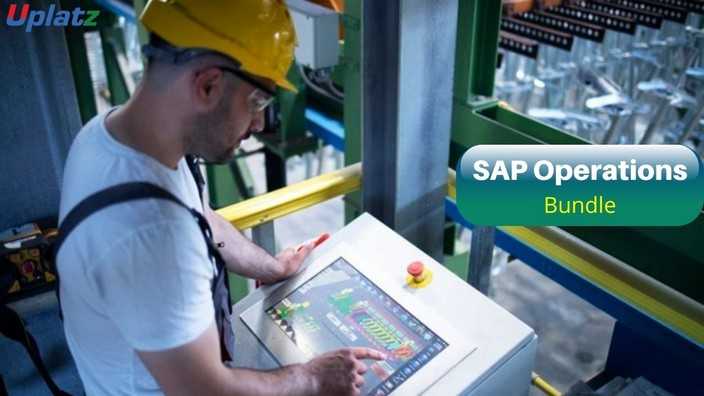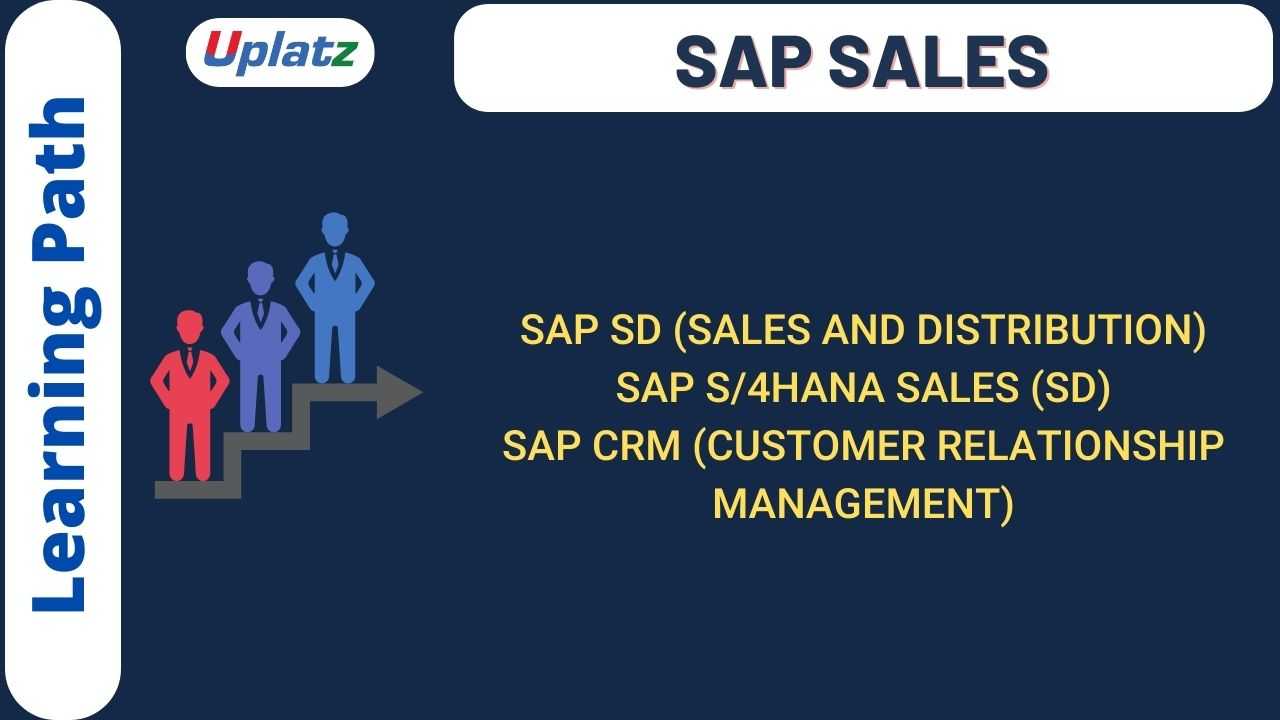SAP S/4HANA SD (Sales and Distribution)
Learn Sales Process, Enterprise Structure, Material Determination, Material Listing & Exclusion, Free Goods, Data Flow, Partner Function in S/4HANA SDPreview SAP S/4HANA SD (Sales and Distribution) course
Price Match Guarantee Full Lifetime Access Access on any Device Technical Support Secure Checkout Course Completion Certificate 88% Started a new career
BUY THIS COURSE (
88% Started a new career
BUY THIS COURSE (GBP 12 GBP 29 )-
 93% Got a pay increase and promotion
93% Got a pay increase and promotion
Students also bought -
-

- Bundle Course - SAP Operations Management
- 250 Hours
- GBP 22
- 4737 Learners
-

- Learning Path - SAP Sales
- 100 Hours
- GBP 29
- 466 Learners
-

- Career Path - SAP Functional Consultant
- 500 Hours
- GBP 99
- 7893 Learners

SAP S/4HANA SD (Sales and Distribution) module helps you maximize revenue and cash flow by managing and integrating the order-to-cash processes across all touch points, channels, and functions. Improve outstanding sales with multichannel, role-based access to accurate, real-time information.
SAP S/4HANA Sales and Distribution module enables the user to monitor, manage, and collaborate on sales orders due for shipping and invoicing, allowing customers and company agreements to be fulfilled easily, on time, and accurately. By using the SAP S/4HANA sales order fulfillment cockpit facilitated by the SAP Fiori frontend user experience (UX), the sales representative can filter sales orders with issues and gain insight into the process execution. They can visualize issues over the entire end-to-end sales process in a single dashboard. SAP S/4HANA SD is a significant upgrade from the traditional SAP SD module, offering a modern, agile, and efficient solution for managing sales, order fulfillment, and customer interactions. It helps organizations become more customer-centric, responsive, and competitive in today's dynamic business landscape.
Additionally, new innovations have been added to improve the overall sales order fulfillment analytics, enabling users to monitor order-to-delivery performance in a better way. In this section, we’ll discuss the sales order fulfillment cockpit functionality and the additional key analytics for sales order monitoring.
SAP S/4HANA Sales is an important module of SAP ERP consisting of business processes required in selling, shipping, billing of a product. The module is tightly integrated with SAP MM & SAP PP. Key sub-modules of SAP SD are Customer and Vendor Master Data, Sales, Delivery, Billing, Pricing, and Credit Management.
Key features of SAP S/4HANA SD include:
1. Simplified Data Model: SAP S/4HANA SD uses a simplified data model, reducing the number of tables and data redundancy. This simplification leads to improved performance and faster data processing.
2. SAP Fiori User Interface: The user interface in SAP S/4HANA SD is based on SAP Fiori, providing a modern, intuitive, and responsive design. Users can access applications from any device, improving user productivity and engagement.
3. Real-time Analytics: Leveraging the power of in-memory computing, SAP S/4HANA provides real-time analytics and reporting. This enables users to make data-driven decisions instantly and gain deeper insights into sales and distribution processes.
4. Advanced Pricing: SAP S/4HANA SD offers advanced pricing capabilities, allowing businesses to define complex pricing structures and manage pricing centrally. This includes dynamic pricing, discounts, and promotions.
5. Revenue Recognition: The module helps businesses comply with revenue recognition standards such as IFRS 15 and ASC 606. It automates revenue recognition processes and ensures accurate financial reporting.
6. Order-to-Cash Process: SAP S/4HANA SD provides end-to-end visibility and control over the entire order-to-cash process, from order creation to billing and revenue recognition. This streamlines operations and enhances customer service.
7. Improved Customer Experience: With integrated CRM capabilities, organizations can better manage customer relationships, track customer interactions, and provide a seamless customer experience.
8. Product Configuration: SAP S/4HANA SD enables product configuration, allowing businesses to offer customized products or services to customers with complex product requirements.
9. Digital Commerce: The module supports digital commerce channels, making it easier to sell products and services online. Businesses can manage e-commerce operations, including B2B and B2C sales.
10. Transportation Management Integration: Integration with transportation management modules provides visibility into shipping and logistics processes, helping organizations optimize delivery and reduce costs.
11. Multi-Channel Sales: SAP S/4HANA SD allows businesses to sell through various channels, including traditional sales, online sales, and partner networks, while maintaining consistent pricing and processes.
12. Advanced Reporting and Analytics: Users can create custom reports and dashboards tailored to specific business needs using SAP Fiori-based analytics apps. This facilitates better decision-making and performance monitoring.
13. Cloud and On-Premises Deployment: SAP S/4HANA SD is available for both cloud and on-premises deployments, providing flexibility for organizations to choose the deployment option that suits their IT strategy.
These key features of SAP S/4HANA SD help businesses streamline sales and distribution processes, enhance customer experiences, and gain deeper insights into their operations, ultimately driving growth and competitiveness.
With this SAP S/4HANA SD course by Uplatz, you will obtain knowledge on SAP S/4HANA and learn how to perform key sales functions in SAP S/4HANA Sales, execute innovative logistics processes, and implement sales processes. You will learn how to implement and customize features of SAP S/4HANA Sales.
Course/Topic - SAP S/4HANA SD (Sales and Distribution) - all lectures
-
In this session, we learn about how SAP S/4HANA SD is different from SAP SD on ECC.
-
In this session, we learn about defining Company, Company Code, Sales Organization, Distribution Channel, Division, Sales Office and Sales Group.
-
In this session, we learn about defining Plant, Storage Location, Shipping Point and assignments of Organizational Units.
-
In this session, we learn about remaining assignments of Organizational Units.
-
In this session we learn assigning Company Code to Fiscal Year Variant, Chart of Accounts and Field Status Variant, Materials Management View on Accounting, Stochoistic Block Values, set Company Code Productive, Financial Management Area, Global Company Code, Cost of Sales Accounting, Taxes, Credit Control Area, Controlling Area and Profit Center.
-
In this session, we learn about Credit Segment, Company Code groups, FM account assignment derivation, Settings for Company Code, Material Ledger and Quantity and Value Updating.
-
In this session, we learn about Business Area, Valuation Grouping Code, Inventory Management, Plant Parameters and Maintenance Planning Plant.
-
In this session, we learn about different views of Material Master like Basic Data 1, Sales org1, Sales: General Plant, Purchasing, MRP 1, MRP 2, MRP 3, MRP 4 and Accounting 1.
-
In this session , we learn about creation of Material Master, Initial entry of Material Stock and Display of Material Stock.
-
In this session, we learn about General Data, Company Code Data, Sales Area Data and Customer account group.
-
In this session, we learn about creation of grouping, Partner Functions and Creation of Customer Master.
-
In this session, we learn about Access Sequence, Condition Type and Pricing Procedure.
-
In this session, we learn about Pricing Determination and creation of Condition Master.
-
In this session, we learn about various fields in Sales Document Type.
-
In this session, we learn about Inquiry, Quotation, Sales Order, Delivery, Transfer Order, PGI, Invoice, Credit Memo Request, Debit Memo Request, Rush Order, Cash Sales, Quantity Contract, Scheduling Agreement, Consignment Fill Up, Consignment Issue, Consignment Pick Up and Consignment Return.
-
Episode 16 - Item Category Type
-
In this session, we learn about Configuration of Cross Selling.
-
In this session, we learn about Configuration of Free Goods.
-
In this session, we learn about Configuration of Third Party Sales.
-
In this session, we learn about Copy Control, Product Proposal, Material Exclusion, Material Determination, Picking and Confirmation, Billing Document types, Creation of Billing Documents, Billing Methods, Billing Plan, Types of Billing Plan, Revenue Account Determination, Credit Management, Output Determination Process and Partner Determination.
-
In this session, we learn about ASAP Methodology for Implementation Project and Support Project.









